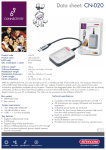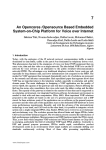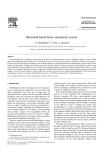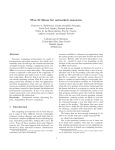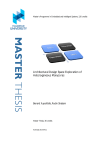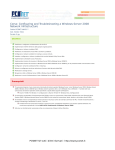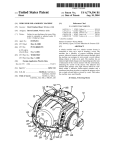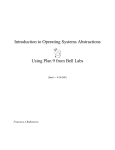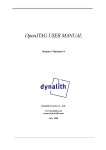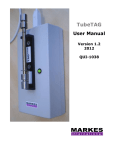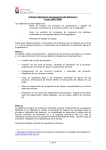Download Secure IP downloading for SRAM FPGAs
Transcript
Microprocessors and Microsystems 31 (2007) 77–86 www.elsevier.com/locate/micpro Secure IP downloading for SRAM FPGAs q J. Castillo *, P. Huerta, J.I. Martı́nez DIET, DAC, Universidad Rey Juan Carlos, Dep. II, D. 157, C/ Tulipan S/N, Móstoles, Spain Available online 28 February 2006 Abstract Nowadays there is a growing number of systems based on FPGAs spread over wide areas. When these kind of systems are used, serious security problems may appear. The configuration data for these devices can be very sensitive information that has to be protected against piracy and reverse engineering. In this paper, the main target is to describe a rapid prototyping platform that allows Secure IP downloading and Rights Management. This platform is based on the possibility offered by the new FPGA families for reprogramming part of the device while the rest is working. This work shows how an FPGA system based on an Open Source OpenRISC 1200 microprocessor takes advantage of this feature to perform the Secure Download of the software and the hardware needed to run a User Application. The platform includes digital signature schemes, symmetric encryption and hashing functions to increment the security. An IP rights management method using this architecture is also presented. Ó 2006 Elsevier B.V. All rights reserved. Keywords: FPGA; Secure configuration; On the field configuration; Partial reconfiguration; Self-reconfiguration; Right management 1. Introduction Nowadays there are a great number of electronic systems distributed over a wide area, for example, a set of net routers in a country or a group of cash points in a city. The growth of the FPGA capabilities has significantly increased the use of FPGA-based systems. It is not difficult to see that the combination of these two factors can lead to a set of potential problems not completely covered today. These problems can be classified in: Local security. An attacker could have physical access to the system. Two different types of attacks against the IP can be achieved: cloning and reverse engineering. Therefore, it is necessary to strengthen the confidentiality of the design contained inside the FPGA. q This work has been supported by the Spanish PROFIT and European MEDEA+ program under FIT-0700000-2003-930 contract. * Corresponding author. E-mail addresses: [email protected] (J. Castillo), pablo.huerta@ urjc.es (P. Huerta), [email protected] (J.I. Martı́nez). URL: http://escet.urjc.es/~jmartine (J.I. Martı́nez). 0141-9331/$ - see front matter Ó 2006 Elsevier B.V. All rights reserved. doi:10.1016/j.micpro.2006.02.001 Secure upgrades. One of the most important features of an FPGA is the reconfiguration capability that makes possible to remotely update the design or to correct a bug. But during the updating, an attacker could have access to the configuration data of the FPGA or the transmission of the data could fail by any other causes. Therefore, it is necessary a mechanism to download in a secure way new or updated designs to a remote FPGA. Rights management. A commercial IP vendor can request a payment each time an FPGA is configured with its IP, or can demand a fee for each updated FPGA. Therefore, there should exist mechanisms to manage these content rights. Before facing the design of a platform that meets the requirements presented above, an evaluation of the different FPGA technologies available in the market is compulsory. FPGAs are mainly based on Antifuse, FLASH, and SRAM technologies. Antifuse technologies have the best Local Security properties. They are programmed once and then place in their final destination. If an attacker tries to extract the configuration data, he will face a hard work trying to analyze the state of the fuses. But on the other hand, if a bug is detected 78 J. Castillo et al. / Microprocessors and Microsystems 31 (2007) 77–86 or a new feature is needed, the FPGA can not be reprogrammed on-the-field. A new system with these new features has to be manufactured and the old system has to be replaced. The way to overcome the three set of problems (local security, secure upgrades, and right managements) is to use SRAM or FLASH FPGAs and to develop methods to protect the system from local and remote attacks. A review of the state of the art covering the most important concepts related with this topic is presented in Section 2. As a result of this study, a platform and an architecture suitable for overcoming these potential problems are described in Section 3. To properly use and take advantage of the platform it is necessary to define and implement a set of mechanisms, which are detailed in Section 4. The implementation details of the platform are presented in Section 5. In order to evaluate the platform, a discussion of possible attacks and the platform resistance is summarized in Section 6. Finally, the conclusions of this paper are presented in Section 7. 2. State of the art 2.1. Local security The topics related with local security have been studied intensively. Different authors have proposed different methods to secure de data locally. In [1] these methods are classified in six categories: Ignorance. The configuration memory layout is secret. This means that an attacker cannot get information about what is inside the FPGA, therefore prevents reverse engineering but not cloning. Encapsulation. The bitstream storage and the FPGA are encapsulated in the same package. This option is offered by FPGA vendors as Lattice or Actel on their FLASH based FPGAs. User-defined key. The user encrypts the bitstream and store it back inside the storage media encrypted. The FPGA will be responsible for reading the encrypted data from the media and decrypt it. The main problem is how to share the encryption key. This is the most extended way of securing bitstreams on SRAM FPGAs, but today some new FLASH FPGAs offer this method to increase protection against attacks. Secured serial memory. This method is based on using specially secured EPROMs with an encryption circuit connected to an FPGA with a decryption circuit. This method is complicated and need specially designed memories, so is not very easy to use. Manufacturer-defined key. This method is similar to the user-defined key. The key is implanted in the FPGA during the manufacturing process, and since every FPGA has the same key this method protects against reverse-engineering but not against cloning. It also has the problem that because the attacker can get many different bitstreams encrypted with the same key, it is much easier to attack and get the key, and when the key is discovered all FPGAs security is endangered. Hardware token-based schemes. This is similar to the hardware tokens used to protect computer programs. The idea is to connect extra hardware, usually a CPLD, to the FPGA and share secret data. It is useful for protecting against cloning but not against reverse-engineering, and is also quite expensive. If the application needs a high level of local security using Antifuse technologies like Actel or Lattice is highly recommended, but if the application needs on-the-field upgrades an SRAM or FLASH FPGA should be used. In order to get a good level of local security, one or more of the schemes previously presented have to be implemented. The conclusion of [1] is that the most suitable method to achieve a high protection against attacks is user-defined key encryption. The question is to decide how to implement this method. Although there are many proposals, the most important FPGA vendors (Xilinx, Altera, Actel) offer very similar bitstream security features [2,3]. In these implementations (Fig. 1), the CAD software generates an encrypted bitstream with a user-defined key and stored in a non volatile memory. The key is also stored in an special register inside the FPGA. When the system is powered up, the FPGA reads the data from the non-volatile memory, decrypts the bitstream and programs itself. Depending on the FPGA’s families the encryption algorithm implemented is different: Xilinx Virtex-II families uses 3DES algorithm whilst Altera Stratix, Actel FPGAs and Xilinx Virtex4 new families use AES. The most important difference between implementations is that Altera and Actel store the key inside the FPGA using a non-volatile memory that not need external power supply whilst Xilinx needs an external battery to store the CAD Tool Key FPGA Storage Medium Encrypted Configuration Secure Channel Decryption Circuit Key Battery (depending of the vendor) Fig. 1. Commercial solutions. J. Castillo et al. / Microprocessors and Microsystems 31 (2007) 77–86 key. Xilinx argues that using an external battery strengthens the system because if an attacker attempts to remove the FPGA from the board to extract it, the key will be lost and the data won’t be recovered. It could be said that it would not be very difficult to keep the power of the FPGA while unsoldering. Each option has advantages and disadvantages: the use of an external battery is more secure but it takes more area and is more expensive. Following the User-defined key idea, [1] proposes an alternative method to encrypt the bitstream on SRAM FPGAs, without the need of an external battery. This method is based on the idea that the key is only known by the FPGA, being the key embedded into the device during the fabrication using laser-programmed fuses. The CAD software generates a plain bitstream that has to be encrypted by the FPGA with the secret key and stored in a FLASH memory. In this method (Fig. 2), the bitstream is sent to the FPGA through the JTAG interface. The FPGA encrypts the data with the secret key and writes it into a FLASH memory. At this point the system is in the same step as the previous approaches: the bitstream is encrypted and stored in a non-volatile memory. At the FPGA power-on the configuration data is read, decrypted and used to program the system. The advantage of not using an external battery is similar to the new FPGA families from Altera, whilst the disadvantage of engraving the key on the FPGA during the manufacturing process makes this method not usable today from a practical point of view because is not implemented by any FPGA vendors. Many other solutions has been patented [4–6], being all based on similar ideas, but currently not available in the market. Another interesting step on local security has been proposed in [7], but has not been implemented yet. It is a novel platform that allows secure configuration of Xilinx FPGAs using the self-reconfiguration capabilities of Virtex-II and Virtex-II Pro families. This proposal includes a configuration controller implemented on a predefined and fixed region of the FPGA that uses the ICAP component (Internal Configuration Access Port) to reprogram the other region of the FPGA. This is A 79 carried out in two steps. In the first one, the FPGA is programmed with the encryption cores needed to cipher the bitstream. In the second step, the data is sent to the FPGA, ciphered and written back to the EPROM. One advantage of this architecture (Fig. 3) is that allows the combination of different encryption methods, without the need of having all the algorithms configured on the FPGA at the same time. For example, if one IP needs to be ciphered with 3DES algorithm, the 3DES core will be programmed in the FPGA using self-reconfiguration, and the IP bitstream encrypted and written back to the EPROM. If a second IP needs to be ciphered with AES algorithm, the 3DES core is substituted by the AES core and the second IP core is ciphered. This method also provides the possibility of not ciphering bitstreams if there is not sensitive information involved. The configuration EPROM will contain some ciphered IPs, some plain IPs, and all the cores needed to perform the decryption of the ciphered IPs. During usual platform operation, if a new IP is needed, the FPGA will program the corresponding decryption circuit, read the IP from the EPROM, decrypt the IP and reprogram itself through the ICAP port. The major drawback of this architecture is how to store the key inside the FPGA. The initial bitstream that contains the configuration controller is not ciphered, therefore an attacker could analyze the bitstream, using for example JBits, and extract the Key. The authors propose to store the key also using fuses but Xilinx FPGAs do not offer this possibility. Therefore, a method to efficiently hide the Key inside the bitstream is needed. In Section 3, we present a real implementation of a system that achieves local security using Virtex-II self-reconfiguration capabilities, as discussed in [7]. 2.2. Secure upgrades The second requirement for a platform to carry out secure IP downloading is to implement a method that provides on-the-field upgrades in a secure way. This is called Secure Update Downloading. This feature makes a lot of sense in terms of system maintainability due to the reprogramming capabilities of the B FPGA FPGA Storage Medium JTAG Encrypted Configuration Storage Medium Decryption Circuit Encryption Circuit Configuration Circuit Encrypted Configuration Key Fig. 2. Solution proposed in [1]. Key 80 J. Castillo et al. / Microprocessors and Microsystems 31 (2007) 77–86 EPROM Encrypted Configuration 1 Encrypted Configuration 2 FPGA No-Encrypted Configuration Configuration Controller (SCP) Decryption Core 1 ICAP Reconfigurable Area Key Decryption Core 2 Fig. 3. Self-reconfiguring solution. FPGAs. For example, correcting a bug when it is detected or adding a new function remotely, with no physical access to the system, is becoming common practice today. The usual way to carry out this operation (Fig. 4) is to have an external microprocessor with a TCP/IP stack connected to the configuration ports of the FPGA. This external processor will download the new bitstream from a remote server and reprogram the FPGA. This possibility is offered by all vendors in different ways [8–10]. Self-reconfiguring capabilities have also introduced new ways to carry out on-the-field updates [11]. This approach is based on the idea of embedding the configuration controller inside the FPGA and self-reconfigure part of the FPGA through the ICAP port. This is done dividing the FPGA into two parts: a fixed area with all the logic needed to manage the communication channel and the self-reconfiguration process, and a reconfigurable area for the applications. A Security Manager is included to be responsible to secure the communication channel between the IP database and the system using symmetric cryptography (Blowfish algorithm). There is also a Data Validation Block responsible for detecting errors during the configuration process (CRC algorithm) that will abort the configuration and reload the initial bitstream again. There are no indications of how to reboot the system, leaving the authors this matter to future publications. The main advantage of this architecture (Fig. 5) is that an external microprocessor is not needed anymore to manage the FPGA upgrades. This fact implies great savings in terms of money, area and power consumption. The main disadvantage is that this platform only allows Secure Power-Up of the system because it does not provide a mechanism to stop the application and begin the downloading of a new one when an update is available. When the application needs a microprocessor, a Soft Core Processor (SCP) could be used, for example, proprietary Xilinx Microblaze [12] or open-source LEON [13] or OpenRISC [14]. In [15] a remotely self-reconfiguring architecture based on the use of an SCP OpenRISC 1200 was presented (Fig. 6). At startup, this system connects to a remote IP database using a TCP/IP connection and downloads the user application. This application is made up of a partial bitstream with the dedicated hardware needed for processing the application and the software to be run in the SCP. When the configuration is finished, the SCP jumps to the user software start point. The system also provides security features by using a DES encryption algorithm. This platform also allows Secure Update Downloading by providing a mechanism to interrupt the system and begin updating. When the communication controller receives the appropriate System Media Interface Security Manager IP database User Application Data Validation ICAP Fig. 5. Self-reconfiguring on-the-field update. Reconfigurable Area Fixed Area Communication Controller Application Software System uP IP database Bus Macro FPGA Configuration Port Fig. 4. Traditional on-the-field update. Reconfigurable Hardware OR1200 Security Controller DES+CRC ICAP Controller Fig. 6. Self-reconfiguring on-the-field update using SCP. J. Castillo et al. / Microprocessors and Microsystems 31 (2007) 77–86 command, the application jumps to the boot software and begins the downloading of the new bitstream. The problem with this implementation is that the Application Software has to be rewritten to work with the communication controller and understand the commands, but fortunately this is not usually very difficult. As shown before, securing a communication channel is the main problem. Unlike in local security, in this case the transmission is carried out remotely through a communication channel like Internet. Storing and keeping the key secure inside the Xilinx Virtex bitstream is achieved applying stenographic techniques and will be discussed later. The former architectures have shown the point of view from the FPGA side. Another interesting work in this field is [16] that only shows the point of view of the IP’s database server. An architecture (Fig. 7) for a Library of Components for Remote Secure Configuration is described, providing high security levels using a ‘‘Hybrib Security Mechanism’’ on the server side. This mechanism uses both Symmetric and Asymmetric Encryption to reinsure confidentiality and authentication during the transmission. 2.3. Rights management Rights management on FPGA devices refers to the right of the IP owner to collect a fee each time a new version is delivered, or an FPGA device is programmed with its IPs. Even though other kind of right management techniques like Watermarking or Signature are really interesting they are not part of this study because they can be used without any modification in this kind of systems. One of the most significant proposals on this field is presented in [17] and patented by Algotronix. The proposed scheme has three phases: when the FPGA is manufactured, when the designer includes cores into his design and when the system that contains the FPGA is manufactured. The scheme is quite complex but the global idea is to deliver the IP encrypted and use a Trusted CAD Software to gen- Hardware/ Software Component 00111011 01111000 11100100 11100001 11110000 01001101 erate a final encrypted bitstream. Then, when this bitstream is programmed, the FPGA system will connect to a Trusted External Party (TEP) and bill the customer. Apart from that, there are powerful cryptographic protocols implemented to ensure the identity and the confidentiality of the delivered IPs. Algotronix scheme has the disadvantage of relying in a Trusted CAD tool and in a Trusted External Party, which at this moment do not exist, and also embedding a secret key with laser inside the FPGA, as in the local security problem. 3. Proposed architecture After analyzing these three problems, a new scheme that allows Secure IP downloading for Xilinx SRAM FPGAs is necessary. This section shows a new architecture based on commercial FPGAs with Partial Reconfiguration features that covers and solves all the problems studied in previous sections. In this architectural proposal (Fig. 8) the FPGA is divided into two parts. The fixed part contains the SCP and is responsible for managing the communication channel and the security schemes implemented on the board, whilst the reconfigurable part is responsible for managing the rest of the tasks: being at the beginning this task the processing of a digital signature and the exchanging a symmetric key thanks to an RSA asymmetric cryptographic core. The operation is divided into two: Secure Power Up and Secure Updates Downloading, depending on the initiation of the process. The differences between them are minimal and will be discussed later. Basically, the whole process is as follows. At the start-up, the FPGA is programmed with a non encrypted initial bitstream. After the FPGA is programmed, a Secure IP download can begin. In both cases (Power-Up and Update Downloading) the SCP connects to the remote IP database and identity itself, using the RSA asymmetric encryption core. When the system is Key Session Generator Session Key TEA (Tiny Encryption Algorithm) Encrypted Component Remote Users Public Key Library Public Key RSA 81 Authentication Fragment Fig. 7. Hybrid security mechanism. RSA Encrypted Transmission Package 82 J. Castillo et al. / Microprocessors and Microsystems 31 (2007) 77–86 Not Ciphered Initial Bitstream Fixed Area Reconfigurable Area Hardware WatchDog Clear Configuration Memory GPIO OR1200 RSA Core Bus Macro Communication Controller Trusted IP Database and Right Management Controller Security Controller AES+MD5 Ciphered Asymmetric Keys ICAP Controller External RAM Fig. 8. Secure IP downloading Platform. properly identified and its rights have been checked, the application (software and hardware) is sent to the system in a secure way. If an error is detected during the transmission or the process fails, an external circuit clears the FPGA and the process is restarted. Finally, the partial bitstream is self-programmed in the reconfigurable area using the ICAP port, the new hardware is reset and the SCP jumps to the downloaded software to start the application. The main elements of the system are the Soft-Core Processor, the Security Controller, and the external Watchdog. data and address buses with multiple masters and slaves. An arbiter decides in each moment which master takes the control of the bus. OR1200 includes a complete SDK based on GNU tools with a GCC compiler, Binutils containing linker and assembler, and GDB for debugging purposes. Many operating systems have been ported to the OpenRisc Architecture: eCos, uClinux, Linux, RTEMS, and microC/OS-II. 3.1. OpenRISC 1200 processor The Security Controller has three main aims. First, the User Application has to be encrypted to protect the data from unauthorized readers, because if the bitstream is not encrypted it can be copied or reverse engineered. Second, the data has to be protected from communication errors or modifications during the transmission, being this achieved by using a digest algorithm. Third, the data source has to be authenticated to ensure that the source of the data is valid. This is done using certificates based on public key cryptography. The implemented Security Controller performs all these operations. It decrypts the data using a 128 bit Key length AES-CBC algorithm and checks its integrity using a MD5 hash algorithm. Authentication and AES key exchange is carried out using a RSA asymmetric key algorithm. The The chosen microprocessor was an OpenRISC1200 core. This soft-core is freely distributed under an LGPL license from the OpenCores website. The OR1200 is a 32bit scalar RISC with Harvard architecture with a 5-stage integer pipeline intended for embedded, portable and networking applications. One of its main characteristics is its configurability. Using a configuration file anyone can add or remove more than ten optional units like data and instruction caches, memory management unit (MMU), power management unit, and many others. The basic communication channel of the platform is an OpenCores Wishbone Compatible Bus. It has synchronous 3.2. Security Controller J. Castillo et al. / Microprocessors and Microsystems 31 (2007) 77–86 Security Controller also contains a Random Number Generator [18] to create challenges for authentication. The Security Controller is divided into two parts: one is placed in the fixed area and is made up of an AES and an MD5 core, the second one is the RSA core which at the beginning is programmed in the reconfigurable area to be later replaced by the application. This is a great advantage because the RSA is a big size core and when it is not needed the space it consumes can be re-used. 83 the FPGA structure to prevent it to be extracted from the bitstream. There are several ways for hiding some amount of data inside a FPGA. In this proposal, the selected option was to mix the 128 bits of the AES key with another 128 bits of random data and use the possibility of Xilinx software to disorder the register bits. The result is a set of 256 disordered bits from where it is difficult to extract the correct key. If higher security level is needed a more aggressive stenographic method could be used, for example methods for watermarking purposes [19]. 3.3. External hardware watchdog 4.2. Authentication process The IP downloading task could fail due to lots of reasons. For example, the transmission could be erroneous or incomplete, the FPGA configuration process itself could fail, or external causes like a glitch in the power supply can lead to a wrong configuration or a hang of the FPGA. If this happens it is compulsory to have a method to detect the problem, recover the initial state of the FPGA and restart the User Application downloading. It is worth remembering that the system could be located in a remote and difficult to access location. In embedded software development the responsible for detecting hangs and restart the program is a watchdog. Taking this idea into hardware, this work proposes the use of a watchdog that is cleared by the SCP periodically using a GPIO. The watchdog is an external element connected to the configuration ports of the FPGA. If it is not cleared after a certain amount of time, normally because the FPGA is not working properly, it resets the device and reloads the initial bitstream. Depending on the selected FPGA programming method, the implementation of this watchdog could vary from just a counter to a more complex logic implemented in a CPLD. 4. Secure IP downloading After describing the system, a detailed description of Secure Power-Up and Secure Updates Downloading methods is presented in this section. 4.1. Initial FPGA configuration The process begins when the FPGA is powered and configured with the initial bitstream contained in some storage media, usually an EPROM memory. This initial bitstream is not encrypted because encrypted bitstreams does not allow subsequently Partial-Reconfiguration of the FPGA device. This initial bitstream is not valuable information, since it is the same for every on-the-field FPGA. The only sensitive information the initial configuration contains is the RSA Private Key which identifies the system. This 1536 bits key is stored inside a Block RAM and is ciphered using AES algorithm to protect it from attackers. The AES key necessary to decrypt the Private Key is hidden inside When the FPGA is programmed the OpenRISC 1200 SCP begins its operation decrypting the Private Key that will be used for authentication purposes using the AES core. The first step of the Secure IP Transfer Protocol is to authenticate both sides of the communication. To perform this task, Public Keys are exchange between the FPGA and the IP Database. Depending on the side, the authentication process will have different steps. In the FPGA side the first step is to compare the Public Key of the Database with the key stored: if they are different the process is aborted, If they are equals the FPGA challenges the server with a random number. This number is encrypted with the server’s Public Key and sent to the server. The IP Database will decrypt the challenge data with his Private Key and send back the result. If the two numbers are equal the server is authenticated. The inverse process is based in the same idea, a challenge created by the IP Database to the FPGA but it is a little bit trickier because the IP Data base has to make some checks to prevent cloning and manage rights. To carry this process out the IP Database keeps a table with information about: 1. Authorized systems. It stores the public key of every authorized system with information about the IPs that can be downloaded. 2. Currently Powered-Up systems. It stores information about all the systems currently booted and the associated IP (Internet Address). This address can change every time the system is booted, for example when it is assigned by a DHCP server, so it can not be used as Identification. It also stores the current Symmetric Session Key. 3. Billing Information. For each authorized system the IP Database stores information about how many times it have been configured and other information suitable for billing purposes. When the IP Database receives the Public Key of the FPGA, it looks up in the table if the system is authorized. If it is then it checks if another device with the same Public Key is Power-Up. If this is the case, the server asks to the first authenticated system if it is alive. If this system 84 J. Castillo et al. / Microprocessors and Microsystems 31 (2007) 77–86 responds to the request, it means that somebody has cloned the FPGA, because there are two systems alive with the same Public Key. Therefore, the transmission is not allowed. If the system with the previous IP address does not answer the server it is assumed that the FPGA has been rebooted and a new DHCP address has been assigned to it. After this step, the server will authenticate the FPGA in the same way described previously using a challenge. 4.3. Download and rights management After both sides of the communication have been authenticated the downloading could start, but before starting they should share a symmetric Session Key. The IP database generates a 128 bits random number which is encrypted with the FPGA public key. Afterwards, the Session key is sent to the system. At this point a secure and trusted communication channel has been established. To request the application, the FPGA sends a packet with an IP download request. The IP Database will check the rights of the system to download the IP. If the FPGA has proper rights, the server encrypts the bitstream with the Session Key and adds a MD5 hash. Then the data is sent using a TFTP-like protocol through the Secure Channel. After the bitstream is sent the billing of the IP is done. The application software is downloaded from the IP database in the same way. 4.4. Secure configuration When the FPGA receives the bitstream, it recalculates the hash and compares it with the hash previously received. If they are not equal, an error during the transmission is detected, and the process is restarted. If the hashes are equal, the decryption and reconfiguration begins. To reinforce the confidentiality of the bitstream this is not decrypted at once and stored in the main memory. This could be an advantage to an attacker that could read the external memory with the decrypted bitstream. Instead, blocks of 128 bits in length are read from the memory, decrypted and written back to the configuration memory of the FPGA through the ICAP. This process continues up to all the bitstream is written back or the FPGA configuration fails and the Watchdog resets the FPGA. After the Application hardware and software are downloaded and configured, the SCP jumps to the Application starting point and starts executing. 2. Pull. Periodically the system asks the IP Database if it has a new update. With the Push, the system has to be informed that a new update is available. This makes necessary to modify the User Application to attend the Secure Communication Channel. When a new update is available the system reboots and downloads it from the server. With the Pull, the system is rebooted after a certain amount of time (every day, once a week, etc.) and downloads a new version of the bitstream. This is much easier but it consumes net resources since the bitstream is downloaded even if a new update is not available. Even worse, remotely located systems could be connected to a communication channel, like GPRS, and get billed for the downloaded amount of not needed data. In these cases a Pull method is not acceptable. However, in cases where the channel is LAN, WLAN or similar downloading few Kbytes every day is not critical. In both cases it is necessary to force the Watchdog to reboot the system because the RSA core contained in the initial configuration is needed during the Download Process. 5. System implementation To develop the FPGA side a Celoxica RC203 development board with a Virtex-II X2CV3000FG676 FPGA has been used. All parts of the system except the Watchdog has been implemented and tested on the board. The Watchdog was not implemented with this board because there is no access to the configuration ports of the FPGA. A new board with this feature has being designed. In Table 1 the size of the elements that made up the Fixed area is presented in LUTs. The total number is not the addition of all the elements because the CAD tools optimize some logic away. The User Application is assigned the 50% of the total area of the FPGA. Looking at the results it could be thought that up to 75% of the total area could be assigned to the User Application. This is not completely true because of the allocation of the pins and the RSA core size. The pins of the peripherals connected to the SCP are located on the right side of the FPGA and since the pins driven by each module of the design have to be located in the area occupied by that module, the fixed part must reserve 50% 4.5. Sending an update to the FPGA Table 1 Secure IP downloading Platform When a new hardware or software update is available the system must be told to begin the download process in order to get the new version of the application. There are two ways for managing this process: Element LUTs OR1200 Security controller ICAP controller Ethernet controller RS232 5423 2460 14 66 761 Total 7102 (23%) 1. Push. The IP Database has a new update and tells the remote system to download. J. Castillo et al. / Microprocessors and Microsystems 31 (2007) 77–86 Table 2 Cycles spent in cryptographic operations Element Packet length Packets processed Cycles per packet AES MD5 ICAP 128 128 8 14058 14058 224930 511 16 16 Total Total cycles 7183638 224928 3598880 85 described above avoids replacement attacks. Even if the attacker gets the Private Key of the server and authenticates itself successfully against the FPGA, it just could send erroneous data, making a DoS (Denial of Service) attack, but the IPs stored in the original server will be safe. 6.3. FPGA system replacement 11007446 of the FPGA to get access to these pins. This is a waste of area imposed by the use of a board not specifically designed for Partial Reconfiguration. Also, the RSA core used for authentication and key sharing imposes a restriction on the size of the User Application area. This core takes up 10838 LUTs, which means 37% of the whole FPGA, therefore at least a 40–45% of the FPGA area must be reserved for the RSA core. The IP Database software was written on a Linux based host using Java and implements all the features previously discussed. The whole process measured in different experiments takes about 5 s. These measures also indicate that the Reconfiguration time through the ICAP port when the data is located in the local external RAM is 725 ms. Even thought the ICAP port can run up to 50 MHz, the SCP is not able to deliver a data each cycle because it has to take it from the external memory and decrypt it. In Table 2, the number of cycles spent by the different elements involved in the process is presented. The experiments have been carried out on a 219 Kbytes Partial Bitstream with a DES encryption algorithm. The total processing time is 423 ms for a 25 MHz clock. In this computation the time spent by the SCP in bus transfers and instruction execution time has not been taken in account. These instructions are responsible for example for the XOR operations in AES-CBC calculations and MD5 padding. The rest of the time, 4 s, is spent in the Ethernet Power-Up and Configuration, and in data transmission. 6. Attacking the platform A brief discussion about possible attacks to the platform and its resistance is presented in this section. 6.1. Sniffing attack The most obvious attack intercepts the communication channel and reads the data travelling in order to get the bitstream. This is a very easy attack and is also very easy to prevent. Symmetric AES encryption of the channel avoids these attacks. 6.2. IP database replacement The attacker can try to pretend being the IP Database. This is not a useful attack. The Authentication Process The other replacement attack is to pretend being the FPGA. As said before the authentication process avoids this possibility. But in this case if an attacker takes the FPGA and extracts its Private Key, it could pretend being the FPGA and transfer the IP with a known symmetric key. In this case it will win. But still, there are ways to prevent this attack. First of all, the Private Key is ciphered and the AES key is hidden inside the FPGA, making very difficult to get the Private Key. But if an attacker has physical access to the system, this can be stolen and the key can be extracted in a laboratory. This can be avoided asking the system periodically if it is alive. If the system is stolen and is under an attack, it will not respond. If the system does not respond in a certain amount of time, its rights on the IP Database will be revoked. Therefore, when the attacker gets the Private Key it will not be valid to download IPs. This is a very high security policy and has to be used carefully because the system could be down for other reasons like a failure in the power supply and in this case rights has not to be revoked. 6.4. Man in the middle attack An attacker has to authenticate itself against the server and the FPGA. Then it has access to all the traffic between them and can get the bitstream. To perform these attacks the attacker has to get the Private Keys on both sides. 6.5. Denial of Service Like any other system connected to a network the system could be the target of a Denial of Service (DoS) attack. There are many ways to perform this kind of attack. For example a brute force method in which the attacker sends lots of requests that makes the system to attend them even when they are false, not attending real connections. Protect the system against this attack is difficult and one possible way could be to ignore all the connections that are not coming from IP database. Even using a firewall is not possible to completely defend the system against DoS attacks. 6.6. Cloning The last attack considered is cloning. An attacker could read the initial configuration of the FPGA and creates a system equal to the original. This system will share the same Public Key. In this case, the cloned system could 86 J. Castillo et al. / Microprocessors and Microsystems 31 (2007) 77–86 connect to the IP Database and download the bitstream. But the attacker will not have access to the bitstream since it is deciphered just in the last moment and block by block, not being readable in any place. Also, the IP Database can detect that two systems with the same public keys and different IP addresses are powered-up at the same time. In this case the rights of the system are revoked. 7. Conclusions In this work, a review of the methods used to secure a FPGA has been presented. They were divided into three groups: local security, secure upgrades, and rights management methods. The main conclusion is that self-reconfiguring architectures have the best security properties and are suitable to implement Secure IP Download mechanisms. A complete system that allows Secure IP downloading has been presented. The platform solves the three problems shown in Section 1: local security by using self-reconfiguration mechanisms, remote updating in a secure way through asymmetric and symmetric encryption protocols, and rights management implementing mechanisms on the server side. The platform is based on an Open Source SCP, the OpenRISC 1200, and has been implemented on a Celoxica RC203 development board with a Virtex-II X2CV3000FG676 FPGA. References [1] T. Kean, Secure configuration of field programmable gate arrays, in: Proceedings of International Conference on Field Programmable Logic and Applications, FPL 2001, Lecture Notes in Computer Science, vol. 2147, Belfast, United Kingdom, pp. 142–151. [2] A. Telikepalli, Is your FPGA design Secure. In Xcell Journal, 2003. [3] Altera, Design Security in Stratix II Devices, http://www.altera.com/ products/devices/stratix2/features/security/st2-security.html. [4] K. Austin, US Patent 5,388,157, Data Security Arrangements for Semiconductor Programmable Devices. [5] Algotronix Ltd., Method and Apparatus for Secure Configuration of a Field-Programmable Gate Array, PCT Patent Application PCT/ GB00/04988. [6] C. Erickson, US Patent 5,970,142, Configuration Stream Encryption. [7] L. Bossuet, G. Gogniat, W. Burleson, Dynamically configurable security for SRAM FPGA bitstreams, in: Proceedings of 11th IEEE Reconfigurable Architectures Workshop, RAW, Santa Fé, USA, 2004. [8] Xilinx, Application Note 412, Architecting Systems for Upgradability with IRL (Internet Reconfigurable Logic), 2001. [9] Actel, Application Note, Programming ProASIC3/E Using a Microprocessor. [10] Altera, Remote System Upgrades with Stratix II Devices, 2005. [11] R. Fong, S. Harper, P. Athanas, A versatile framework for FPGA field updates: an application of partial self-reconfiguration, in: Proceedings of 14th IEEE International Workshop on Rapid System Prototyping, RSP, San Diego, USA, 2003, pp. 117–123. [12] Xilinx Inc. Microblaze Processor Reference Guide. [13] Gaisler Research, LEON2 Processor User’s Manual. [14] D. Lampret, OpenRISC 1200 IP Core Specification, 2001. [15] J. Castillo, P. Huerta, J.I. Martı́nez, A Secure Self-Reconfiguring Architecture based on Open Source Hardware, in: Proceedings of International Conference on Reconfigurable Computing and FPGAs, Reconfig, Puebla, Mexico, 2005, pp. 224–230. [16] M. Pérez Gutierrez, M. Arias-Estrada, Library of hardware/software components for remote secure configuration, in: Proceedings of International Conference on Reconfigurable Computing and FPGAs, Reconfig, Colima, Mexico, 2004, pp. 350–359. [17] T. Kean, Cryptographic rights management of FPGA intellectual property cores, in: Proceedings of the 2002 ACM/SIGDA Tenth International Symposium on Field-programmable gate arrays, Monterey, USA, 2002, pp. 113–118. [18] T. Tkacik, A hardware random generator, in: Revised Papers from the 4th International Workshop on Cryptographic Hardware and Embedded Systems, CHES, Lecture Notes in Computer Science, vol. 2523, San Francisco, USA, 2002, pp. 450–452. [19] J. Lach, W. Mangione-Smith, M. Potkonjak, Signature hiding techniques for FPGA intellectual property protection, in: Proceedings of the 1998 IEEE/ACM International Conference on Computer-aided Design, San Jose, USA, 1998, pp. 186–189.










